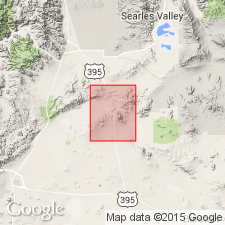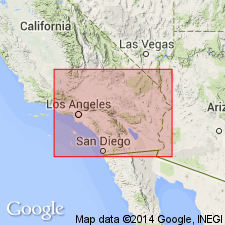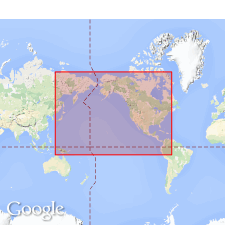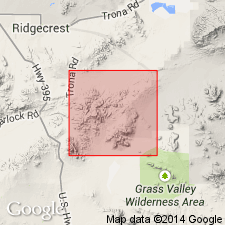
- Usage in publication:
-
- Atolia quartz monzonite*
- Modifications:
-
- Original reference
- Dominant lithology:
-
- Quartz monzonite
- AAPG geologic province:
-
- Mojave basin
- San Joaquin basin
Summary:
Pg. 33-42, map. Atolia quartz monzonite. Occurs in Randsburg quadrangle, Kern and San Bernardino Counties, southern California. Intrudes Rand schist and the undifferentiated Paleozoic series of El Paso Mountains, which may be in part Carboniferous. Unconformably underlies middle Miocene sediments (Rosamond series). Is undoubted correlative of pluton rocks of Sierra Nevada and is probably of Late Jurassic age.
Named from exposures at and around Atolia, San Bernardino Co., southern CA.
Source: US geologic names lexicon (USGS Bull. 896, p. 88).

- Usage in publication:
-
- Atolia quartz monzonite*
- Modifications:
-
- [Incidental mention]
- AAPG geologic province:
-
- Mojave basin
- San Joaquin basin
Summary:
Pg. 509-510, table 4. Atolia quartz monzonite. Mentioned in discussion of crystalline rocks of southern California. Listed on table as late Mesozoic.
Source: US geologic names lexicon (USGS Bull. 1200, p. 167).

- Usage in publication:
-
- Atolia Quartz Monzonite*
- Modifications:
-
- Overview
- AAPG geologic province:
-
- Mojave basin
- San Joaquin basin
Summary:
The USGS currently designates the age of the Atolia as Cretaceous(?) on basis of study now in progress. [See entry under Smith (1964).]
Source: US geologic names lexicon (USGS Bull. 1200, p. 167).

- Usage in publication:
-
- Atolia Quartz Monzonite*
- Modifications:
-
- Age modified
- AAPG geologic province:
-
- Mojave basin
Summary:
Mapped in Lava Mountains of San Bernardino Co, CA; exposed over large areas in northwestern and southern parts of map area. Described as plutonic rocks approximately quartz monzonite in composition; includes aplitic and leucocratic rocks in northwestern area and some hornblende granodiorite in southeastern area. Cretaceous age is suggested for batholithic rocks of southwestern Basin Ranges and Mojave Desert on basis of more than 20 lead-alpha age determinations (Jaffe and others, 1959). Atolia Quartz Monzonite is assigned Cretaceous(?) age.
Source: GNU records (USGS DDS-6; Menlo GNULEX).
For more information, please contact Nancy Stamm, Geologic Names Committee Secretary.
Asterisk (*) indicates published by U.S. Geological Survey authors.
"No current usage" (†) implies that a name has been abandoned or has fallen into disuse. Former usage and, if known, replacement name given in parentheses ( ).
Slash (/) indicates name conflicts with nomenclatural guidelines (CSN, 1933; ACSN, 1961, 1970; NACSN, 1983, 2005, 2021). May be explained within brackets ([ ]).

